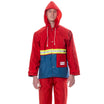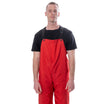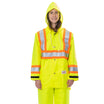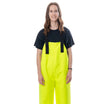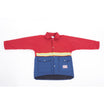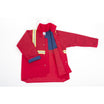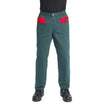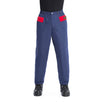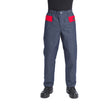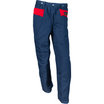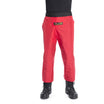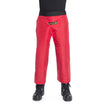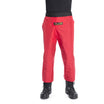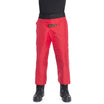Chainsaw Pant Care Guide
***Critical Information About Your Saw Pants and Chaps***
- Regularly inspect your saw pants to ensure they are not compromised in any way; this is important to ensure you are always protected.
- Treat your chain saw pants and chaps as a piece of CRITICAL safety equipment.
- Keep them as clean as possible. Correct and timely cleaning reduces general wear and tear and the pants/chaps flammability from oils and solvent soiled materials
-
The best time to do this is AFTER each use so that you can take the necessary action to replace them.
How You Know When to Replace Your Saw Pants or Chaps:
- The outer shell has numerous holes and cuts; these holes allow bar oil to contaminate the Kevlar pad
- Wood chips and sawdust are evident inside the layers at the bottom of the pants or chaps
- Improper sewing repairs to the outer shell include stitching through the Kevlar pad; this will prevent the Kevlar pad fibers from moving, which lowers the level of cut-through protection
- Improper cleaning using detergents with bleach additives decrease the level of cut-through protection
- The outer shell is caked with oil and dirt deposits that can’t be removed with cleaning. Testing has shown that such deposits can affect the performance of the Kevlar pad
- The pant or chap has sustained an exhaust burn. Burns usually mean that fabric layers are potentially fused together compromising the pants or chaps effectiveness
- ANY PANTS OR CHAPS THAT HAVE PREVIOUS CHAIN NICKS THAT HAVE TOUCHED THE KEVLAR PAD REQUIRE IMMEDIATE REPLACEMENT
Careful Storage:
Keeping your CRITICAL equipment stored properly and clean ensures maximum protection.
- Make sure the pants or chaps are completely dry before storing them to prevent mold
- Hang them up if possible as heavy objects piled on top can damage the material, clasps, buckles, etc.
- Keep them out of direct sunlight and away from direct heat
- Ensure that if stored in the back of a truck or cargo box that they are NOT rubbing on equipment and tools
- Do not store them on top or under your saw, chain oil and gas
Understanding the Materials Used
Synthetic, Non-FR Rated Materials
- The following Saw Pants and Chaps are constructed of Synthetic materials including knit polyester; polyurethane coated nylon; woven polyester
Natural, Non-FR Rated Materials
FR Rated Materials
Saw Pants and Chaps Pre-Wash Instructions:
Regular washing is key to maintaining the integrity of the pants and chaps.
Check any pockets for woodchips and loose external debris.
Remove any dirt with warm water and mild liquid soap
Remove any oil, soot, grease and other hydrocarbon contaminants with products such as Citrosqueeze ( www.ppes.ca/citrosqueeze.html )
Remove pitch and sap by gently scraping off as much as you can without touching the fabric and then apply rubbing alcohol with a cotton ball until it lifts off.
Washing Synthetic Non-FR Rated Pants and Chaps:
It is best to use soap that is designed specifically for washing garments with water repellent finishes such as Nikwax ( www.nikwax.com/en-ca/products/Cleaning/tech-wash/ )
If not using a product such as Nikwax, use only a mild detergent (such as WIN detergent made for synthetic fabrics - https://www.windetergent.com/ )
It is best to hand wash when possible by soaking the product in a sink with 10-15 gallons of diluted Citrosqueeze for overnight and then using a bristle brush to scrub them.
Rinse them thoroughly with cold water and hang in doors or out, but not in direct sunlight.
For light soiling use a spray bottle of diluted Citrosqueeze (1:10 dilution with water) and scrub with a bristle brush. Rinse thoroughly with cold water when finished cleaning and hang to dry.
If using a washing machine ONLY use a gentle cycle like “Permanent press” and use warm to cold water only.
Do not use powder or liquid clothes detergents
Do not us bleach or products that contain Bleach
Do not use products that contain fabric softeners’ or perfumed products
Washing Natural Non-FR Rated Pants
It is best to use a mild non-bleach liquid detergent
Follow the prewash procedures of removing dirt and grim
It is always best to hand wash, however a washing machine can be used
Turn the pants inside out and select a delicate wash cycle like “Permanent press” or “Cotton” using luke warm to cold water.
Once the cycle is completed remove the pants immediately, turn them right side in, straighten out the legs and hang dry.
Do not put in the dryer
Do not Use detergents
Do not us bleach or products that contain Bleach
Do not use products that contain fabric softeners’ or perfumed products
Washing FR-Rated Pants
Always wash FR-Rated pants in a different wash than non-FR Rated pants
Use only a mild detergent (such as WIN detergent made for synthetic fabrics - https://www.windetergent.com/ )
It is best to hand wash when possible by soaking the product in a sink with 10-15 gallons of diluted Citrosqueeze for overnight and then using a bristle brush to scrub them.
Rinse them thoroughly with cold water and hang in doors or out, but not in direct sunlight.
For light soiling use a spray bottle of diluted Citrosqueeze (1:10 dilution with water) and scrub with a bristle brush. Rinse thoroughly with cold water when finished cleaning and hang to dry.
If using a washing machine, turn the pants inside out and ONLY use a gentle cycle like “Permanent press” using warm to cold water only.
Once the cycle is completed remove the pants immediately, turn them right side in, straighten out the legs and hang dry.
Do not put in the dryer
Do not us bleach or products that contain Bleach
Do not use products that contain fabric softeners’ or perfumed products
Drying Instructions
Remove garments from the washing machine and HANG DRY only - inside or in the shade outside
Do Not hang garments in the sun as this will prevent UV damage
Do Not Dry garments in a dryer
Do Not Dry garments in front of a fire or other heat source
Revitalizing Compromised Gear:
Use a spray bottle and apply the liquid evenly over the pants
Hang Dry overnight - inside or in the shade outside



